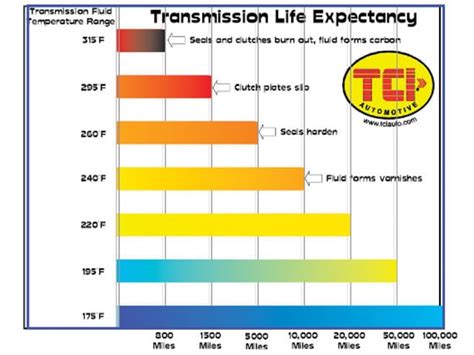How High Should Transmission Temp Be
Ronan Farrow
Apr 04, 2025 · 3 min read

Table of Contents
How High Should Transmission Temperature Be? A Comprehensive Guide
Maintaining the optimal transmission temperature is crucial for the longevity and performance of your vehicle's transmission system. Running too hot or too cold can lead to serious issues, impacting both drivability and your wallet. This guide will help you understand the ideal transmission temperature range and what to do if your transmission is running too hot or too cold.
Understanding Normal Transmission Temperatures
The ideal operating temperature for most automatic transmissions falls within a range of 150°F to 220°F (66°C to 104°C). This range allows the transmission fluid to maintain its viscosity and lubricity, ensuring smooth gear changes and efficient power transfer. However, specific temperature ranges might vary slightly depending on the vehicle's make, model, year, and driving conditions. Always consult your vehicle's owner's manual for the manufacturer's recommended operating temperature.
Factors Affecting Transmission Temperature
Several factors can influence your transmission's temperature:
- Driving Style: Aggressive driving, frequent acceleration and braking, and towing heavy loads can significantly increase transmission temperature.
- Ambient Temperature: Extreme outside temperatures, both hot and cold, can affect the transmission's ability to regulate its temperature. Hot weather will naturally raise operating temperatures, while very cold temperatures can thicken the transmission fluid, hindering lubrication.
- Transmission Fluid Condition: Old, contaminated, or low transmission fluid reduces its cooling capacity and increases the risk of overheating. Regular transmission fluid and filter changes are essential for maintaining optimal temperatures.
- Transmission Condition: A malfunctioning transmission, such as a faulty torque converter or internal problems, can cause it to overheat.
Signs of an Overheating Transmission
An overheating transmission can manifest in several ways:
- Transmission slipping: The transmission may slip or hesitate when shifting gears.
- Burning smell: A distinct burning odor can be detected, typically coming from the transmission area.
- Rough shifting: Gear changes might become rough or delayed.
- Warning lights: Your vehicle's dashboard may illuminate a check engine light or a specific transmission warning light.
- Overheating symptoms: The transmission might feel excessively hot to the touch (use caution!).
What to Do if Your Transmission is Overheating
If you notice any signs of an overheating transmission, take immediate action:
- Pull over safely: Avoid further stressing the transmission by immediately pulling over to a safe location.
- Turn off the engine: Let the engine cool down before attempting to restart.
- Check the transmission fluid level: Consult your owner's manual for the correct procedure to check the transmission fluid level. Do not remove the dipstick while the transmission is still hot.
- Check for leaks: Inspect the transmission for any visible leaks.
- Seek professional help: An overheating transmission often requires professional attention. Contact a qualified mechanic for diagnosis and repair.
Signs of a Transmission Running Too Cold
While less common, running a transmission too cold can also cause issues. Extremely low temperatures can thicken the fluid, leading to sluggish shifting and potential internal damage. You might notice:
- Delayed shifting: The transmission takes longer to shift gears than usual.
- Harsh shifting: Gear changes may feel abrupt or jarring.
What to Do if Your Transmission is Running Too Cold
If you suspect your transmission is running too cold, consider these factors:
- Ambient Temperature: Is it unusually cold outside?
- Recent Fluid Change: Has the transmission fluid recently been changed? If so, ensure the correct type and amount were used.
- Professional Inspection: If the problem persists, consult a mechanic to rule out any underlying mechanical issues.
Conclusion: Maintaining the Right Temperature
Keeping your transmission within the ideal operating temperature range is vital for its optimal performance and longevity. Regular maintenance, including fluid changes and mindful driving habits, can help prevent overheating and other related problems. By understanding the signs of both overheating and under-cooling, you can take proactive steps to ensure your transmission remains healthy for years to come. Remember to always consult your owner's manual and seek professional help when needed.
Featured Posts
Also read the following articles
| Article Title | Date |
|---|---|
| How Far Is Cuba From Key West By Boat | Apr 04, 2025 |
| How Great Our Joy Sheet Music | Apr 04, 2025 |
| How Hot Is Too Hot For Intake Air Temperature | Apr 04, 2025 |
| How Did Ryan Selwood Die | Apr 04, 2025 |
| How Do I Get A Copy Of My Cpap Prescription | Apr 04, 2025 |
Latest Posts
-
How Long After Botox Can You Get Laser Hair Removal
Apr 05, 2025
-
How Long After Botox Can You Do Microneedling
Apr 05, 2025
-
How Long After Botox Can I Tan
Apr 05, 2025
-
How Long After Botox Can I Microneedle
Apr 05, 2025
-
How Long After Blepharoplasty Can I Wear Mascara
Apr 05, 2025
Thank you for visiting our website which covers about How High Should Transmission Temp Be . We hope the information provided has been useful to you. Feel free to contact us if you have any questions or need further assistance. See you next time and don't miss to bookmark.
